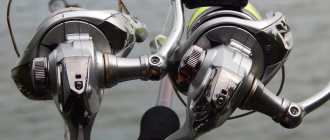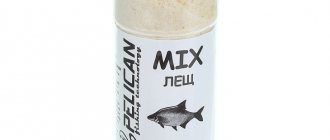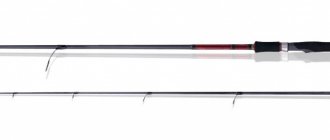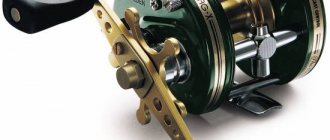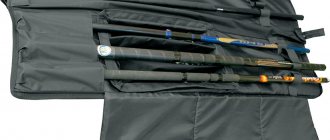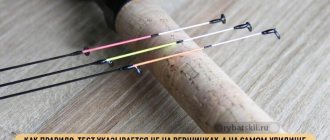When assembling a spinning rod, the fisherman will need several important components, among which braided fishing line . Today, a large number of its options are presented on the shelves of fishing stores.
Modern technologies have allowed manufacturing companies to create lightweight and durable
fishing line for any style of fishing. Fishermen have the opportunity to choose standard monofilament or a more modern and durable almost double braided cord .
What to give preference: fishing line or cord
The fishing line or cord is selected based on what kind of fishing is planned and where it will be carried out. It is important to decide whether it will be fishing with casting over long distances or short distances. Fishing line , which is represented by monofilament, is not capable of delivering bait when fishing from long distances. As a result, the fisherman will be faced with the problem of lack of catch.
This standard fishing line will cope at short distances; it can be used for fishing, where it will show its best side. At distances greater than 256 meters, this type of spinning line is useless. For long casting distances, braiding , which does not lose its shape when using bait.
To determine which cords are more effective for spinning rods , you need to pay attention to the style used when wiring. If a fisherman uses jigs and twitching, which require a high level of clarity, then he will need a cord of high strength and rigidity.
The braid will provide excellent wiring even over short distances. But difficulties may arise with landing fish during trophy fishing. Braided cord lacks elasticity. But to solve the problem, you can use a spinning , which has the option of adjusting the friction brake.
Each fisherman, at his own discretion, can give preference to either a standard fishing line or modern braided line . Each of them can be used depending on fishing style and other criteria. But still, braid shows more advantages. A thin thread, which is created on the basis of fishing lines of small diameters , makes a great contribution to the efficiency of fishing.
Advantages and disadvantages of wattle
An indicator that braided fishing line is in an advantageous situation compared to monofilaments is its ideal rigidity. This characteristic directly affects the sensitivity and controllability of the equipment, which is a fundamental factor for the angler when fishing. Low stretchability instantly transmits even the slightest bite to the quivertip, and the movement of the bait is felt with every vibration.
An important argument among the advantages is the high strength of the threads with a relatively small diameter, which makes it possible to reduce the resistance of the cord when casting and more effectively resist the current, as well as significantly reduce the roughness of the equipment. Artificial threads are durable in use, as they are inert to ultraviolet radiation, temperature changes, drying and freezing, and natural decomposition, which in some cases negatively affects monofilament.
Another advantage is its plasticity, which allows you to knit knots from the material without fear of significant loss of strength, as well as the lack of memory. This property allows you to eliminate defects from twisting the braid when rotating the feeder or bait, and also not to worry about maintaining the straightness of the structure when releasing the cord from the spool or reel of a fishing reel.
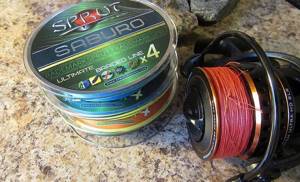
For objectivity, it is worth pointing out that the material is not an ideal find in fishing and has a number of disadvantages that affect the quality of fishing. First of all, this is the lack of shock-absorbing properties, and this is a direct dependence on the excess of rigidity, which complicates the landing of large fish. High surface roughness puts additional stress on the rod when casting, increases the degree of contamination of the cord and affects the streamlining of the fishing line, which in the water collects any debris that touches the base and floats nearby.
For what purposes can braids be used?
Braid is a strong and reliable fishing line consisting of several threads. It can be used for the following purposes:
- Long-distance casting support;
- Low windage rates when fishing in windy weather;
- Increasing the level of bait sensitivity;
- Provides the best visibility in the water for some types of fishing;
- Prevents stretching during sharp hooking;
- Duration of service life.
One of the main advantages of braided fishing line for fishermen is its simplicity and long-term storage. It can be bought in reserve and stored for five years. After which it will not lose its characteristics. Moreover, when wound on a drum, it will still retain its shape. The braid includes the following components:
- Weaving from several layers;
- A substance that prevents rapid wear of gear;
- Impregnation used to improve the slip of fishing line in water;
- Impregnation from harmful sun exposure.
Tips for choosing
How to choose a braided fishing line is a question that is relevant for many inexperienced fishermen. The quality of this product greatly influences the success of fishing and helps the fisherman quickly resolve difficult situations that arise when landing fish. When choosing braid for your fishing tackle, pay attention to the following product parameters.
- Strength. The braided cord must have a good margin of strength so that when fishing in reservoirs with a rocky bottom, it does not quickly wear out on stones and snags. A strong lace will never break when hooks form (more likely, the hook with the nozzle will break, or you will pull a huge snag or a sheaf of algae out of the water). When choosing a braided line for your fishing rod, compare the expected dimensions of the fishing trophy with the possible hooks and breaking load of the cord itself.
- Thickness. For casting a hook with bait over long distances, thin braided line is more suitable. If you choose this type of equipment, do not forget about durability. This parameter does not in any way affect the thickness of the cord, but makes it less vulnerable to aggressive factors of the underwater environment.
- Breaking load of braid.
Choose a product with a different breaking load threshold to have more opportunities for fishing for fish of different sizes. A good fisherman's arsenal must include braided fishing lines with a breaking load suitable for fishing with a specific tackle. For example, it is better to equip a side fishing rod with a braided cord that can support the weight of a fish up to 25 kg. If you prefer fishing with ultralight or light, then the breaking load of the braid should be calculated for a prey weight of 4.5-7.5 kg. - The “roundness” (diameter) of a braided line. The intertwined fibers give the product a flattened or rounded shape. Flat fishing line is difficult to wind onto a reel spool; it often gets tangled, and when casting, it creates a “sail” effect (especially in strong winds). Wicker scaffolding with a flattened shape wears out faster and requires replacement more often.
- Impregnation quality. Today, most manufacturers of braided fishing lines use impregnation of the fibers with a special composition that improves the characteristics of the product. The main task of impregnation is to protect the thin thread from various unfavorable factors (for example, sharp stones, water, sun, low and high air temperatures, abrasive elements). It also increases the strength of the fishing line in the area of knots and makes the product glide better. An important point to pay attention to when choosing a braided material concerns the stability of the impregnation. It should stay on the surface of the fishing line well and for a long time, without peeling off. When buying impregnated braid, look to see if there are any crumbling particles in the package. If there are any, it is better not to take this equipment, because the protective impregnation will quickly be washed off with water and erased when unwinding the cord or winding the reel onto the spool.
It is impossible to check the quality of braided fishing line at the time of purchase. There are some indirect signs indicating that the product does not meet the required quality parameters. However, you can find out the true characteristics of the cord only at the moment of fishing.
To choose a good braided fishing line and not run into a fake, take on board the following professional tips:
- use braided fishing line of the same brand for fishing in order to quickly distinguish it from counterfeit analogues (which have an odor uncharacteristic of the original product);
- buy braided line only in a trusted fishing store, where products from the world's leading manufacturers are presented and there is a quality certificate for each product;
- Before purchasing, inspect the braided cord on the reel, and if there is damage on it (scuffs, differences in color, adhesions), it is better to refuse to purchase a low-quality product;
- immediately upon arriving home from the store, wind the fishing line onto the reel spool (it is advisable to wet the thread before this procedure - when wet, it will fit better and fit completely into the reel);
- inspect the product again, and if you notice a defect, return the product to the store (according to the law, the buyer has the right to return a defective product within 14 days after its purchase).
Take care of the braided fishing line, lubricate it periodically with silicone spray (if you fish in winter). At the end of the summer fishing season, rewind the braided line to the other end.
Rules for choosing braid for a spinning fishing rod
Every fisherman who is a fan of spinning rods should remember that to choose one universal cord for fishing. Sometimes even experienced fishermen have difficulty choosing the right option. And for beginners it is even difficult to figure out which braided cords to choose. This happens for the reason that today there is no unified classification of fishing lines . And manufacturers cannot make the process of making cords more streamlined. As a result, numerous options are presented on store shelves, among which it is difficult for buyers to choose the ones suitable for their spinning rods .
When purchasing, it is recommended to pay attention to fishing conditions. This will allow you to determine the approximate parameters of what type of fishing line may be required.
braided cord options on the market. They may differ from each other by standard characteristics:
- Diameter;
- Length of skein in reel;
- Color.
You can choose according to various criteria.
What is a float rod
Before discussing the choice of fishing line for a float fishing rod, it is worthwhile to dwell on the fishing rods themselves and clarify what they actually are and what varieties they have. For many beginners, a float rod seems to be the most unpretentious fishing tool with a line along the length of the rod and a float adjustable in depth. In general, this resembles the well-known standard of a conventional fly rod. Indeed, in such a fishing rod, the fishing line with a leash should not be longer than the rod (preferably 1/9 of the rod itself), so that you can easily hook and catch the caught fish with your free hand. But does this mean that if the length of the rod is six meters, you will fish at the same distance from the shore + fishing line with a leash of 5.5 m = 11.5 m?
It's not like that at all. From here you will have to subtract the distance from you to the water (at least one meter, if you do not wade into the water), and the depth at which you will fish, for example, also 1 meter (since the length of the tackle ends at the float, because at this point the line goes to the bottom and no longer moves away from the shore). We have: 11.5–2 = 9.5 (m). And if you fish from the leeward side, then the tackle with bait will constantly wash to the shore, making the fishing range even shorter.
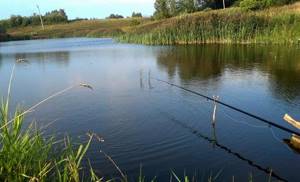
Many people are not happy with this distance. It is clear to anyone that the further you cast the fishing rod, the greater the opportunity to catch a large specimen. Therefore, many float rods are equipped with reels, and in low windy weather the tackle can be cast over a long distance. Therefore, we have to choose the fishing line for the float rod based on the following criteria:
- casting distance;
- type of fishing (fly, match, etc.);
- type of reservoir (lake with standing water, river with fast current, etc.);
- level of vegetation (reeds, bottom algae, etc.);
- water purity (cloudy, clear, green).
Selection by weaving type
Cord weaving can be classic or multi-filament. In the first option, several polyethylene fibers with identical diameters . The tackle may include 16 such threads. As a result of their interweaving, a strong structure is obtained that practically does not stretch. The cut of such a braided line is not even. For this reason, it does not have a long service life. It wears out quite quickly during use. The thread begins to fray, then delamination and loss of reliability.
This version of braided fishing line will be an excellent solution for a novice fisherman. Due to its short service life, it does not have a high cost, and will be affordable for any beginning fisherman.
The multi-filament cord has the same production principle as its predecessor. It also consists of a large number of polyethylene fibers. But at the same time, it has an important difference, which is that the threads in the product are not intertwined, but glued together. Some manufacturers use pressing techniques for production. For gluing, a special adhesive composition is used, thanks to which the product acquires high strength. This adhesive layer prevents abrasion of the product. The composition of the glue varies from manufacturer to manufacturer. There is no universal substance that glues the fibers fishing cords All companies keep the composition of the glue used secret. And the strength and reliability of the gear depends on it. As a result of gluing fibers, durable products with perfectly even cuts are obtained. The service life of such gear is longer, but the cost is also higher than that of products with classic weaving.
Multi-filament cords are soft and have a long service life. When this braid is used while fishing, it is an excellent assistant when casting over long distances. During long-term use of such a product, it loses its qualities. Its structure becomes more flattened. As soon as it becomes completely flat, it is recommended to replace it.
Main characteristics of braided lines
The main parameters of braided fishing lines are breaking load, diameter, elongation, shelf life, color, number of strands and method of weaving, as well as the ability to withstand mechanical stress, sunlight and temperature changes.
The main advantage of braids over fishing lines is their high tensile strength with a small diameter. For example, models with a cross section of 0.15 mm can withstand 5-7 kg, while monofilament lines of the same diameter can withstand 2-3 kg. The difference, as we see, is more than double.
If we talk about the diameter of the braids, then not all models have a constant value. With not very high-quality braids, the diameter may vary in different areas. For example, at first it may be 0.12 mm, but after 10 meters it will be 0.13 or 0.14. After another 10 meters the diameter will again be 0.12 mm. Naturally, such indicators are unacceptable. Especially for thin cords that are designed for spinning fishing.
Sometimes you can read or hear that the diameter of the braid is a relative concept and that the importance of this parameter should not be exaggerated too much. This position is imposed precisely by those manufacturers who do not know how to make braiding according to standards. The diameter is the most important parameter of a braided cord. Therefore, Power Pro or Fire Line cords, being the best braided fishing lines, have such a price, their diameter does not change along the entire length. In many ratings, these braided fishing lines are in first place.
And another important point is the strength of the product. On all boxes for braids the strength value in Libra (Lb) is written. One Libra contains approximately 0.45 kg. Let's take a specific example: SUFIX 832 cord
It has a breaking load of 10 Lb and a diameter of 0.2 mm. Not the most outstanding indicators, but for the example this is not so important. The package also displays the value in kilograms (4.5 kg). This means that the fishing line must withstand such weight in water.
There are opinions that the breaking load may not correspond to that specified by the manufacturer. It can go up, but down it can’t. It doesn’t matter at all what dyes are used in its manufacture, or what kind of impregnation the cord has. The breaking load is clearly indicated on the box. If it is higher than the real one, it means the product is defective or you are looking at a low-quality fake.
It's very easy to check the load. Cut a meter-long piece of cord and tie it to a rigid rod, or better yet, to a steel rod or regular stick. At the other end, tie a weight equal to the specified value. Hold the load for at least half a minute. If the line does not break, then the test will pass. No laboratories are needed for such a simple test.
The second most important characteristic of braided fishing lines is the lack of elongation. What does this give to the fisherman? Zero stretch allows you to see gentle bites on the feeder tackle at a distance of more than 70 meters from the shore. You simply won’t see such bites with the same tackle, but using nylon fishing line.
Why is there such a difference? It’s very simple, if the roach barely moves the bait lying at such a great distance from the shore, then the impulse from the hook to the tip of the tip is damped by the stretchable fishing line. There are bites, but the tip does not move. This often happens in mid-autumn when fishing for passive fish. The tackle is reeled out, and a fish sits on the hook, but no bites are noticed. There are no such surprises when fishing with non-stretch braid. All bites will be visible and there will be no need to guess with reeling out the equipment.
Another key advantage of braid over fishing line is that it can scan the bottom and determine its structure. By dragging a weight along the bottom, you will identify an area of shell, sand, silt, clay, grass and stone. If there is fishing line on the spool, then you will not get 50% of such information.
The picture is approximately the same in spinning fishing. The difference between braided lines and monofilament lines is even more pronounced. For example, we fish with a small foam rubber using the jig method near a snag. This is quite a difficult task. The bait should be held close to the branches, sometimes even touching them. All contacts with the bottom and objects should be immediately transferred to the tip of the spinning rod. Such thin wiring is easier to do if the spool is wound with braid. The fishing line will not provide the same sensory sensations and wiring will often be done at random. And the greater the fishing distance, the worse the connection between the angler and the bait when fishing with a monofilament.
The same can be said about fishing with surface baits: poppers and wobblers. If at short distances and when fishing in areas without a current it is possible to more or less control the bait and perform sharp jerks, then when fishing at long distances and in areas with a current, the control noticeably drops and the jerks are not of such quality.
Jig fishing gained such great popularity precisely with the advent of braided cord. Previously, of course, they used regular fishing lines to jig, but not every spinning player was able to do it well. As soon as the fishing line was changed to a cord, jigging became much easier. Any spinning player can master it. With braid you can make the bait move the way you want. All jerks, pauses and reelings will be transferred to the silicone, balancer, castmaster and spinner. The cord will allow you to make a high-quality step, uniform and uneven wiring, and perform vertical trolling from a boat.
For these reasons, many modern fishermen seek to buy braided fishing line in order to fully experience all the benefits of feeder and spinning fishing.
Selection by thickness
The diameter of braided tackle for a spinning rod is not an exact measurement. Its indicators may have errors, which some manufacturers indicate on the packaging in the product characteristics. In any case, companies usually indicate only an approximate value, which may differ from the actual one, but not by much. The market offers products a diameter ranging from 0.06 to 0.8 millimeters. In order to check the accuracy of the thickness indicator on the marking, you can use a special device for measuring diameter. To obtain more accurate indicators during measurement, it is recommended to apply to the product the load that is maximum for it, according to the manufacturer.
It should be noted that thickness is an important indicator. It is this that determines the quality of the braid . And during intensive use, you should be aware that the fishing line will change its diameter and become more and more flat.
Color characteristics
In terms of the range of colors, wattle is not inferior to, and even superior to, monofilament. The color can be matched to any shade of water and the angler’s preferences.
Important! But it is worth considering that dyed fishing line is significantly inferior in strength to natural light-colored fibers.

Recently, manufacturers, to give a certain shade to the accessory, have woven multi-colored threads into the structure, thus achieving a balance of strength. Khaki color is considered universal . During the fishing process, most lines lose color over time, approaching the tone of the natural color.
Select by color
Fans of spin fishing have been debating for many years over how important the shade of braid . Some anglers believe that fishing becomes more effective when the color of the fishing line matches the shade of the water. There is also a group of fishermen who are confident that different colors of this type of gear are used more for comfort. The bright colors make it easier to keep track of which direction the bait is moving. But no matter what angle fishermen have on the shade of fishing line, the modern market offers a huge number of options in a variety of colors.
Braids are presented in the following tint solutions:
- Black;
- White;
- Exotic rich, almost acidic.
Braids today are becoming more and more colorful. At the same time, many fishermen are convinced that the brighter the color, the less durable it is. However, this is a huge misconception. Thanks to the use of modern dyeing methods by manufacturers, even after applying a chemical coloring composition to the fishing line , it does not lose its reliability. And it is also worth noting that over time, after intensive use of the braided line of the brightest acidic shades, it loses its color and becomes, like any other type of fishing line, gray and dirty.
Best Inexpensive Braided Cords
Sufix Matrix Pro
Rating: 4.8
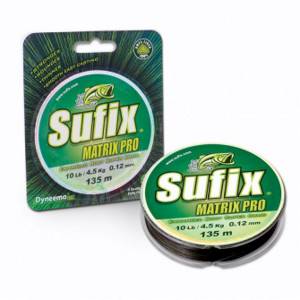
High-quality braided line from Sufix, designed for catching large predators. Despite the transitional position between the budget and the middle price segment, it is a real “fighter” with a huge margin of safety. It is supplied to the market in several unwinding options (135 and 250 meters), as well as with various cross-section options (up to 0.50 millimeters). Actually, with such indicators, the maximum supported weight also reaches enormous values: about 67.5 kilograms at maximum speed.
As users note, the Sufix Matrix Pro braided cord appears to be an exceptionally sensitive cord, capable of distinguishing even the thinnest and weakest bites (as far as the diametrical thickness allows). This quality largely characterizes its enormous popularity among fishermen of any level, and the price parameter once again emphasizes its focus on the solvency of the majority.
Advantages
- wide range of sections in the line;
- high tensile strength of the braid;
- the purest high-modulus Dyneema polymer in the composition;
- availability of unwinding for 135 and 250 meters;
- high-quality external coating that performs protective functions.
Flaws
- not detected.
Kosadaka Infinity
Rating: 4.7

This may seem strange, but the Kosadaka company, widely known for reels, spinning rods and various lures, has completely lost its position in the braided fishing line market. A small and even more unexpected “cure” in the company’s flaw was the Infinity line, designed specifically for power work on reservoirs. The range of diameters within this model range is between 0.03 and 0.40 millimeters, which has a very good effect on the variability of fishing methods in the reservoir. In addition, the load characteristics of each individual section are also striking. So, it seems that the thinnest thread of the same 0.03 millimeters can withstand up to 2 kilograms of dynamic load, which corresponds to a good ultralight and is quite suitable for catching an average pike.
Consumer notes revealed that Kosadaka Infinity braided cord also performs well when tying knots, maintaining almost nominal strength when special stress risers are created. It does not absorb moisture, does not perceive radiation and does not slow down when sliding along the inside of the ring, thereby ensuring a good casting range. Adding to all this the low price for unwinding 150 meters, we get an almost ideal fishing line for everyday fishing.
Advantages
- excellent load performance even with a small thread cross-section;
- a huge number of thickness variations within the model range;
- excellent knot strength;
- low susceptibility to abrasive wear;
- high sensitivity.
Flaws
- not found.
Selection by number of plexuses
The strength of the cord depends on the number of weaves. It is calculated based on the number of fiber weaves per centimeter. If the product description indicates approximately 5-6 plexuses, then such a product can support fish weighing up to 5 kilograms. fishing line can be used for trophy fishing.
Stronger and more expensive products have at least 8 plexuses. They are more durable and can withstand no more than 10 kilograms. With such a line it is quite possible to go catching such serious fish as pike.
braided line options . The number of weaves in them is at least 12 per centimeter. With this gear you can go fishing to catch fish weighing up to 20 kilograms. It could even be a catfish.
Weaving technology
Braided fishing line is produced using two methods. The first method involves weaving a certain number of monofilaments into a single whole and, as a result of impregnation with adhesive compounds, forming the structure of a miniature twisted rope. The second method involves parallel folding of monofilaments into a common base and further sintering of the threads into a strong, homogeneous structure, but with dissimilar rods. Braids made using the second method are more reliable and have a cleaner and smoother surface, which significantly reduces the friction force. It is not surprising that such threads are more expensive than glued structures, which are less durable due to ruptures of individual threads due to excessive friction loads, which causes ruffles in the structure and is a defect in the material.
